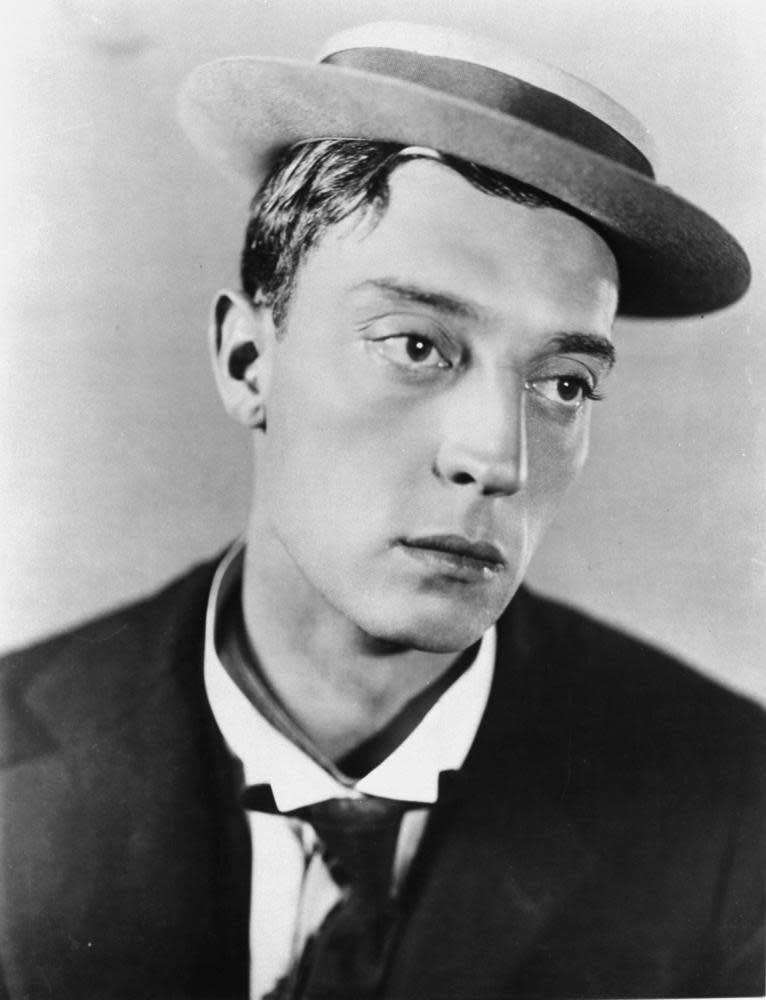Silent witness: unseen Buster Keaton sketches underline his comic genius
Buster Keaton, king of the silent movie, death-defying stuntsman and one of Hollywood’s greatest comedians, was also a great believer in the art of improvisation. “As a rule, about 50% you have in your mind when you start the picture and the rest you develop as you’re making it,” he once told an interviewer.
Now, however, two previously unpublished sketches have come to light in which Keaton appears to undermine his commitment to making it up as he goes along, with jokes mapped out in minute and colourful detail.
Alek Lev, vice president of the International Buster Keaton Society, likened the papers to a “holy relic”, telling the Observer: “We have the honour of preserving laughs that Buster wrote for the world but didn’t get a chance to make.”
The rare sketches, which were bought by the society at auction last year, will be shared for the first time at a major international convention on Keaton later this year. Each is about two pages long and neatly typed in capitals by the man himself. Dating from the 1950s, they may have been intended for his short-lived television series. The sketches would have had sound, but no dialogue.
“These have never been seen,” Lev said. “The first thing that hits you is that Buster Keaton took these actual pieces of paper, loaded them into a typewriter, and typed out these sketches. Have you ever held in your hand a script typed out by one of the greatest directors in history? There’s the holy relic feel of them. It’s also just great to see him planning out gags in the most minute detail.”
In one of the sketches, titled “The Manicurist”, Keaton causes havoc in a salon. He wrote: “The set suggests a barber shop … On the wall, a sign gives the price of shave, haircut etc ... Buster enters. He is dressed for winter with ... mittens … attached by [an] elastic band that runs through the sleeves of the coat … With some difficulty he looks at his watch that is in his vest pocket and after removing his right mitten he takes an envelope from his inside coat pocket.”
It bears a train ticket: “When he unfolds it, we see that [it] is about two feet long. He checks the train time … and decides to wait …”

Chaos ensues after the manicurist puts Keaton’s hand in a bowl of water, not realising that he is holding the ticket, which is now soaked. Keaton must somehow dry it while also retrieving his right-hand mitten, which has become trapped in a drawer that the manicurist has just closed: “To do so, he would have to touch [her] bosom. He lays the wet ticket across his knees and tries to pull the mitten in his left hand off with his teeth. The tension of the elastic is too great …”
The second sketch, titled “Camping Out”, opens in an “apartment with one room containing a pull-down bed, a wash bowl and water pitcher on a commode … Buster enters … mopping his brow. From his coat pocket he takes several folders. They are elaborate vacation advertisements.”
Having selected a camping trip, he then struggles to remove coins from his piggy-bank, taking a hammer to it against the wall, only for it to be “pushed through the plaster” and beyond reach: “Buster strikes a match and tries to look down into the opening. In doing this, he burns his nose which causes him to drop the lighted match down through the opening ... A little smoke emerges … Buster rushes to water pitcher … He starts tearing away portions of the plaster … The head of the landlady appears through the opening in the wall. She glares menacingly at Buster.” He then prepares to go camping, with disastrous consequences.
As well as his comic genius, Keaton – whose masterpieces include The General, an American civil war comedy – is lauded for having developed technical camera innovations and special effects that are unsurpassed today.
Although considered among the greatest of all the silent comedians, he continued to appear in the talkies until his death in 1966. Nicknamed “the Great Stone Face”, he kept a straight face through any calamity, from car crashes to cyclones, once saying: “The more serious I turned, the bigger laugh I got.”
His daredevil stunts with breathtaking acrobatics included those seen in Steamboat Bill, Jr, where he stands motionless as the entire front of a building collapses around him, his body perfectly framed by its open window.
Over the last 25 years, the society has dedicated itself to his legacy, securing rare personal writings, his notes for The General and, most recently, a trove of unpublished photographs.
It is staging the Keaton convention on 3 and 4 October, his 125th birthday. The event was originally due to take place in his vaudeville summer-home of Muskegon, Michigan, but due to Covid-19 it will be online, with screenings, rare footage and appearances by family members.
King of comedy: fast facts
• Buster Keaton, whose real name was Joseph Frank Keaton, was born on 4 October 1895 and was best known as an actor in silent films.
• A master of physical comedy, he was also a film director, producer, and screenwriter.
• His 1926 film, The General, is widely regarded as a masterpiece which influenced many in the film industry, notably Orson Welles.
• As silent movies gave way to “talkies” Keaton signed a deal with Metro-Goldwyn-Mayer, something he came to regret saying it stifled his creativity.
• Married three times, Keaton battled alcoholism. He later branched out into television and comedy writing.
• He died, aged 70, on 1 February 1966 of lung cancer.

 Yahoo Finance
Yahoo Finance 